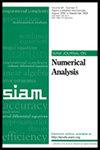Primal Hybrid Finite Element Method for the Helmholtz Equation
IF 2.9
2区 数学
Q1 MATHEMATICS, APPLIED
引用次数: 0
Abstract
SIAM Journal on Numerical Analysis, Volume 63, Issue 1, Page 54-80, February 2025.Abstract. This study addresses some previously unexplored issues concerning the stability and error bounds of the primal hybrid finite element method. This method relaxes the strong interelement continuity conditions on the unknown [math] of a boundary-value problem, set in terms of a second-order elliptic partial differential equation, by means of a Lagrange multiplier [math] defined on the mesh skeleton. We show how the decomposition of the space of shape functions for the approximation of [math] allows us to derive conditions, simple to verify, ensuring the inf-sup condition of Brezzi and Babuška, crucial for the stability of the discrete problem, both in two and three dimensions. An adaptation of the analysis of the mixed finite element approximation of the Helmholtz equation [math] in [G. J. Fix and R. A. Nicolaides, SIAM J. Numer. Anal., 17 (1980), pp. 779–786] enables us to give stability conditions and error bounds, explicit in the mesh size [math] and [math]. Some numerical experiments show that the primal hybrid finite element method is more robust than the usual continuous finite element method with regard to dispersion anomalies, known as the pollution effect, particularly on well-smoothed meshes.
亥姆霍兹方程的原始混合有限元法
SIAM数值分析杂志,第63卷,第1期,第54-80页,2025年2月。摘要。本研究解决了一些先前未被探索的关于原始混合有限元法的稳定性和误差边界的问题。该方法利用定义在网格骨架上的拉格朗日乘子,放宽了二阶椭圆型偏微分方程边值问题的未知强元间连续性条件。我们展示了形状函数空间的分解如何用于[数学]的近似,使我们能够推导出条件,简单验证,确保Brezzi和Babuška的相互作用条件,这对于离散问题的稳定性至关重要,无论是在二维还是三维。[G]中Helmholtz方程的混合有限元近似分析的改编[数学]。J. Fix, R. A. Nicolaides, SIAM J. number。分析的。, 17 (1980), pp. 779-786]使我们能够给出稳定性条件和误差界限,在网格大小[math]和[math]中明确表示。一些数值实验表明,对于色散异常(即污染效应),特别是在光滑网格上,原始混合有限元方法比通常的连续有限元方法具有更强的鲁棒性。
本文章由计算机程序翻译,如有差异,请以英文原文为准。
求助全文
约1分钟内获得全文
求助全文
来源期刊
CiteScore
4.80
自引率
6.90%
发文量
110
审稿时长
4-8 weeks
期刊介绍:
SIAM Journal on Numerical Analysis (SINUM) contains research articles on the development and analysis of numerical methods. Topics include the rigorous study of convergence of algorithms, their accuracy, their stability, and their computational complexity. Also included are results in mathematical analysis that contribute to algorithm analysis, and computational results that demonstrate algorithm behavior and applicability.

 求助内容:
求助内容: 应助结果提醒方式:
应助结果提醒方式:


